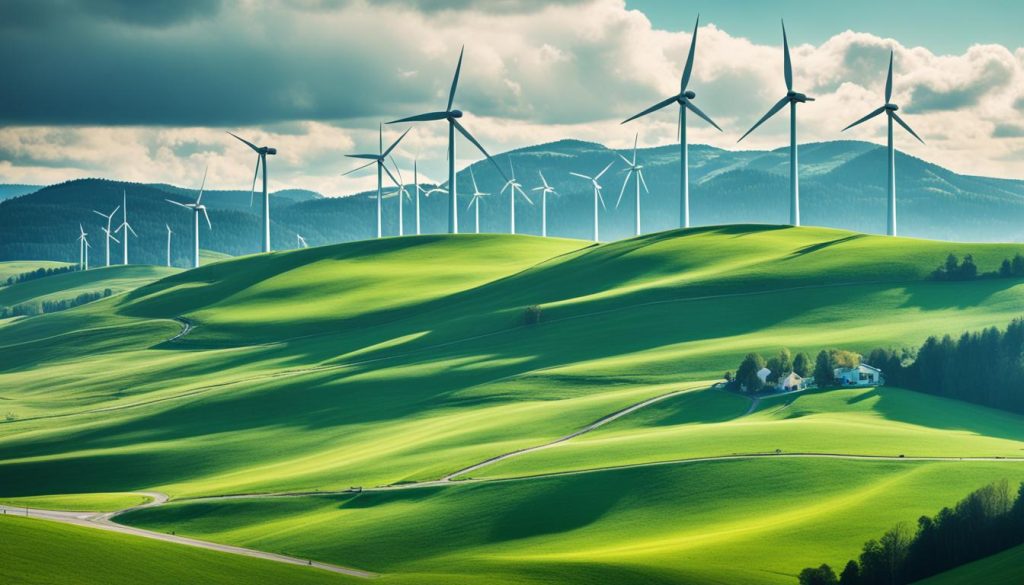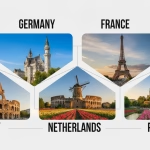The “Energiewende” is Germany’s big change to use more green energy. They aim to be secure, sustainable, and rich. This switch shows in using more renewables for power. By 2023, over half of their electricity comes from green sources. This is a big jump from just over 6% in 2000. Wind power plays a big role in this change.
- Introduction to the Energiewende
- Renewable Energy in Electricity Generation
- Growth of Solar Energy in Germany
- The Role of Biomass in Heating and Cooling
- Heat Pumps and Solar Thermal Systems
- Renewable Energy in the Transport Sector
- The renewable energy sector in Germany
- Impact on Carbon Emissions
- Germany’s Legislative Framework for Renewables
- The Phasing Out of Nuclear and Coal
- Onshore and Offshore Wind Energy Developments
- Investment in Hydrogen Energy
- Energy Efficiency and Consumption Reduction
- Energy Storage and Grid Innovation
- Germany’s Renewable Energy Sector in a European Context
- Source Links
Biomass is the main green source for heating and cooling. Germany also uses solar power and heat pumps. In transport, they are also making progress. They use more biodiesel, bioethanol, and electricity now.
Key Takeaways
- The Energiewende shows Germany’s push for a safer, greener energy future that creates wealth.
- By 2023, green energy makes up over 50% of Germany’s power.
- Wind power is a major part of this increase.
- Biomass plays the largest role in making heating and cooling greener.
- Transport is slowly using more green energy, especially biodiesel, bioethanol, and electricity.
Introduction to the Energiewende
The Energiewende is Germany’s serious plan for an energy change. It wants to change the way the country gets its energy. The big idea is to use more renewable energy like wind and sun power. This change is important because it helps fight climate change. By 2030, Germany wants 80% of its electricity to come from renewable sources. It aims to stop all carbon emissions by 2045 as part of its strict climate protection plan.
Overview of Germany’s Energy Transition
The Energiewende wants to stop using dirty fossil fuels. It’s pushing for more clean, green energy from sources like wind, sun, and plant materials. This move will cut down on the amount of energy used. It will also increase the use of green energy. This big change shows the world that Germany is leading the way in using sustainable energy.
Goals and Objectives
The Energiewende has big goals. It wants to stop using coal by 2038. This is to make energy production cleaner. By 2030, nearly all of Germany’s electricity should come from clean sources. And by 2045, it aims not to add to the carbon in the atmosphere at all. This plan relies heavily on wind energy, both on land and at sea. It also plans to heavily use solar power. These actions show how serious Germany is about its energy and climate goals.
Renewable Energy in Electricity Generation
Germany is on a mission to generate electricity from renewable sources. This journey started in 2002 with a small 6.3 percent share. By 2023, this grew to a massive 51.8 percent. Germany has shown the world what it means to lead in green energy.
Historical Progress and Milestones
Germany’s shift to renewable electricity has hit several key points. By 2013, they had passed the 25 percent mark. In 2023, they reached an impressive 272 billion kilowatt-hours. These steps forward show Germany’s strong will to improve.
The Role of Wind Power
Wind power plays a crucial part in Germany’s green energy story. It’s now the leading renewable source in their energy plan. Thanks to better wind tech, Germany has achieved great progress in producing clean electricity. Wind power is key to Germany’s future energy goals.
Growth of Solar Energy in Germany
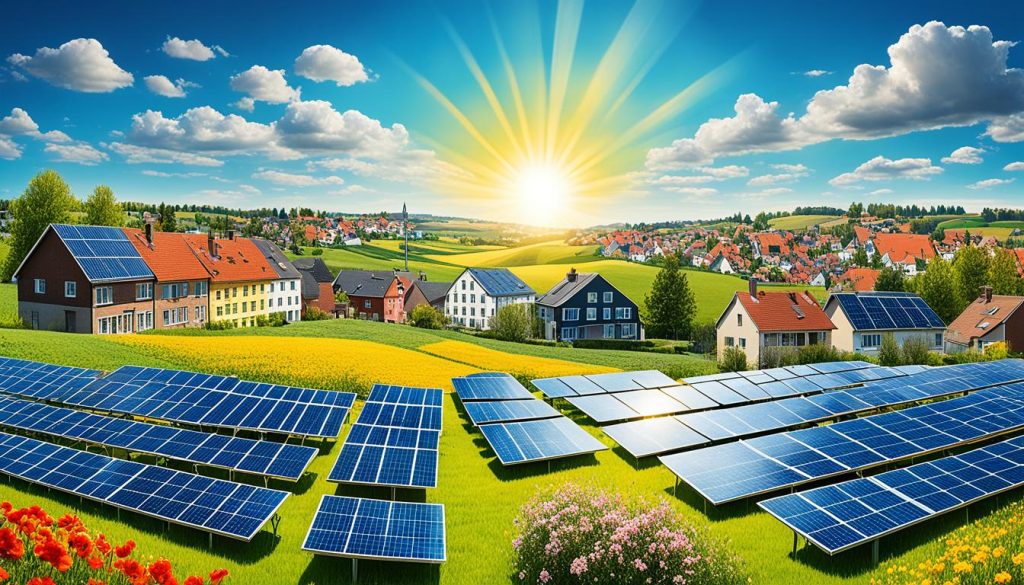
Germany is a pioneer in promoting solar energy. It has shown a strong commitment to using renewable sources. This dedication has resulted in a sharp increase in the use of solar panels.
Current Statistics and Future Projections
Germany now has millions of solar panels, making a big difference in its energy supply. Experts believe the numbers will keep growing. They say Germany’s solar power might double in the next ten years.
Government Support and Initiatives
The German government has played a key role in boosting solar energy. It has offered incentives like subsidies and tax benefits. These have helped make solar power systems more popular and accessible.
Thanks to such support, the country is on its way to a green, renewable future.
The Role of Biomass in Heating and Cooling
Biomass energy is key in Germany’s heating and cooling. It made up most of the renewable heat in 2023. This shows it plays a big part in keeping heating eco-friendly and efficient. Biomass is crucial for Germany’s goal in using renewable sources.
Biomass Contributions and Benefits
Biomass energy has many benefits. It lowers greenhouse gas emissions and makes our energy supply safer. Because it comes from local sources, it cuts down on imported fuel needs. This helps rural areas, giving them jobs and boosting their local economies.
Using biomass also means we use up waste. This makes our energy creation kinder to the planet.
Innovations in Biomass Technologies
Today, we use biomass energy in smarter ways. Newer techniques and efficient boilers have made biomass systems better. They pollute less and give more energy. Innovations also lead to biogas and biofuels. This expands our renewable heating options for homes and businesses.
Heat Pumps and Solar Thermal Systems
In Germany, both heat pump technology and solar thermal systems are becoming more popular. This shows the country is serious about using renewable energy more.
Heat pumps work by collecting energy from the air, ground, or water. They can then turn this energy into heat or cool air for homes and businesses. This method is good for the planet because it uses less fossil fuels. It also helps places be more energy-efficient.
Solar thermal systems are also growing in Germany. They use the sun’s energy to create hot water and heating. This technology is often used in homes and businesses. Its use has made Germany a leader in finding new ways to use green energy.
Germany is working hard to include more diverse renewable energy sources. The rise of heat pumps and solar thermal systems is a good sign. It shows Germany’s strong move towards using more renewable energy.
Renewable Energy in the Transport Sector
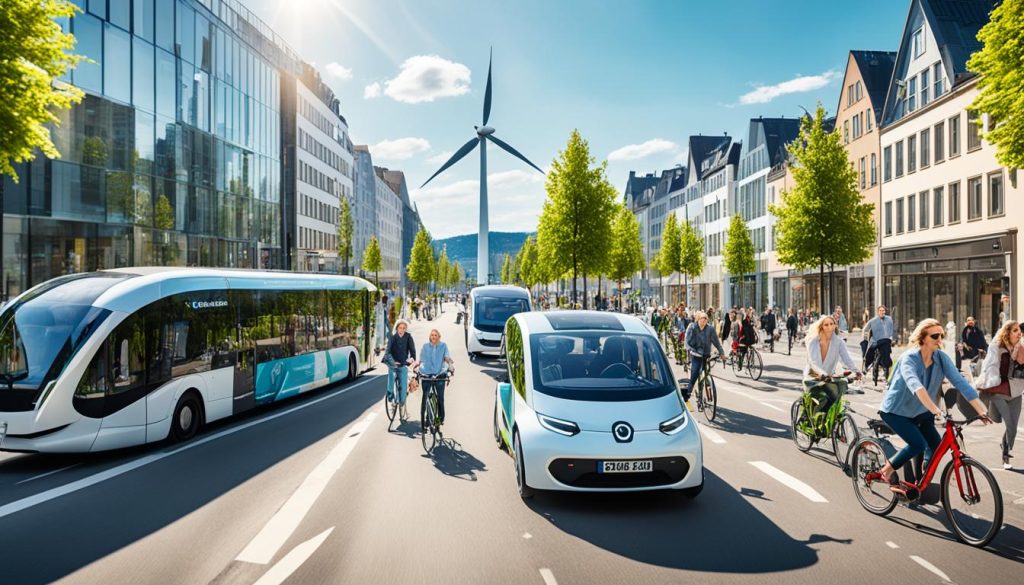
Germany is making big moves towards green energy in its transport. It’s using biodiesel, bioethanol, and electric cars more. This change is important for making transport sustainable and cutting carbon emissions.
Biodiesel and Bioethanol Usage
Biodiesel is now a key part of how Germany runs its transport more cleanly. Mixing it with regular diesel cuts down on harmful emissions, making the air clearer. Bioethanol is used instead of petrol, helping to lower greenhouse gas emissions towards sustainable transport aims.
Electric Vehicles and Charging Infrastructure
Electric cars are becoming more popular, thanks to better technology and people caring more about the environment. A lot of charging stations are being set up across the country. So, it’s getting easier for everyone to charge their electric cars, making the switch smoother.
In Germany, making transport greener is part of a bigger plan to be more sustainable. They’re working hard to make more charging stations and use biodiesel. This helps the country get closer to its green goals.
The renewable energy sector in Germany
Germany is a leader in renewable energy. It’s pushing towards a cleaner future. With strong laws and new tech, it’s on the path to reach big green goals.
Current Status
In Germany, over half the electricity now comes from renewable sources. This is a big step away from oil and gas. It shows how serious the country is about going green.
Future Goals
Germany plans to do even better in green energy. It wants more wind, solar, and bioenergy in its mix. The aim is to be at the front of the world in clean power.
Impact on Carbon Emissions
Germany’s push for renewable energy is key in cutting down its carbon footprint. In 2023, the country avoided about 250 million tonnes of carbon dioxide equivalents. This big drop shows how vital renewable energy is in reducing harmful emissions.
Emissions Avoided Through Renewables
Germany is making great strides in reducing emissions by switching to renewables. Wind, solar, and biomass energy have lessened their need for fossil fuels. This change is not just lowering their carbon footprint. It’s also inspiring other countries to aim for a cleaner planet.
Comparative Analysis with Fossil Fuels
Renewables are clearly better than fossil fuels for the planet. Fossil fuels have damaged our environment for years. But, renewables are changing this by offering sustainable and clean energy. This is a huge step in reducing Germany’s carbon footprint.
Germany’s Legislative Framework for Renewables
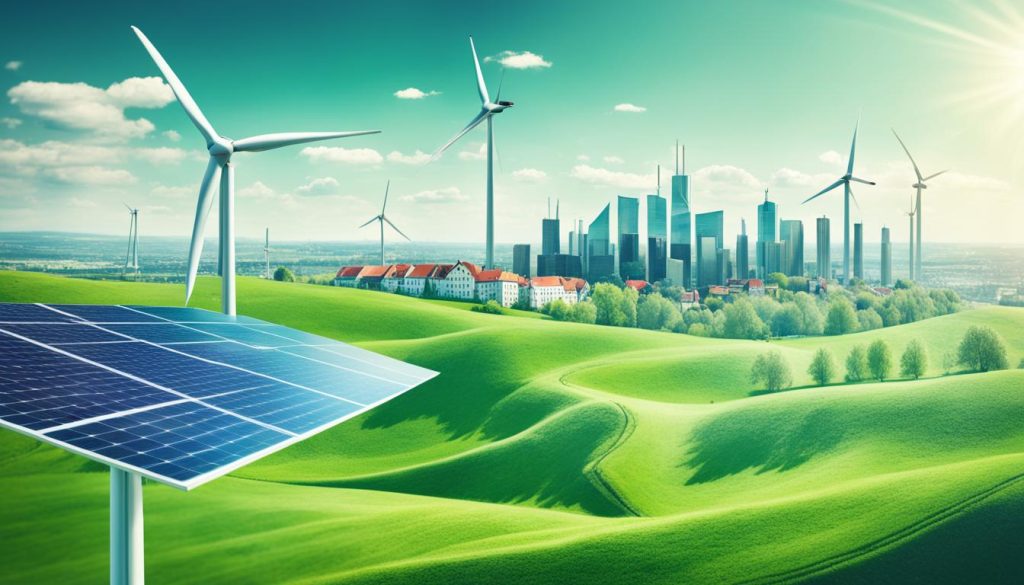
Germany takes its commitment to renewable energy seriously. They have put in place strong laws to help change how energy is used in the country. These measures are crucial for moving towards renewable energy sources.
Key Laws and Regulations
The Renewable Energy Sources Act (EEG) is a key law. It helps by giving money to those who use renewable energy. The Climate Protection Law makes sure companies try to be greener by setting tough goals to cut pollution.
Major Reforms Supporting Renewable Energy
New changes in laws and policies are making the shift to renewable energy easier. Updates to the EEG aim for bigger goals and better funding, helping renewable energy grow. Also, more money goes into building the infrastructure for green technologies, making Germany a top player in this area.
The Phasing Out of Nuclear and Coal
Germany is taking big steps towards a greener future by ending nuclear and coal use. This shows the world a strong example of moving towards clean energy.
After the 2011 Fukushima disaster, Germany started closing nuclear plants for safety. It’s also working to shut down coal plants. These actions aim to reduce pollution and support clean, sustainable energy for the future.
The country is also investing in renewables thanks to the German Renewable Energy Act (EEG). This law makes using green energy more attractive. It guides Germany away from nuclear and coal for a balanced, green tomorrow.
- Nuclear Energy Phase-Out: All nuclear power plants will close by 2022, ending an era in energy use.
- Coal Exit: By 2038, all coal plants will shut down. This plan includes steps to use less coal over time.
These bold moves show Germany’s commitment to clean, sustainable energy. By getting rid of old energy ways, it’s paving the path for a green future. This makes Germany a role model in global energy changes.
Onshore and Offshore Wind Energy Developments
Germany has advanced in onshore and offshore wind energy. This boosts the country’s wind power and helps create a sustainable energy path.
Current Capacity and Future Targets
Onshore wind farms in Germany lead in the wind power availability. Offshore wind projects, although smaller, are growing fast. Germany aims high for 2030, planning to greatly increase its wind energy use. It wants to become a top global name in renewable energy efforts.
Challenges and Opportunities
Still, there are hurdles, like getting permissions and finding the best places for wind farms. Overcoming these challenges is crucial for wind energy’s ongoing success. But, with new tech and fresh ideas, there are great chances for growth. Taking advantage of these opportunities could lead to more wind power and meet Germany’s green goals.
Investment in Hydrogen Energy
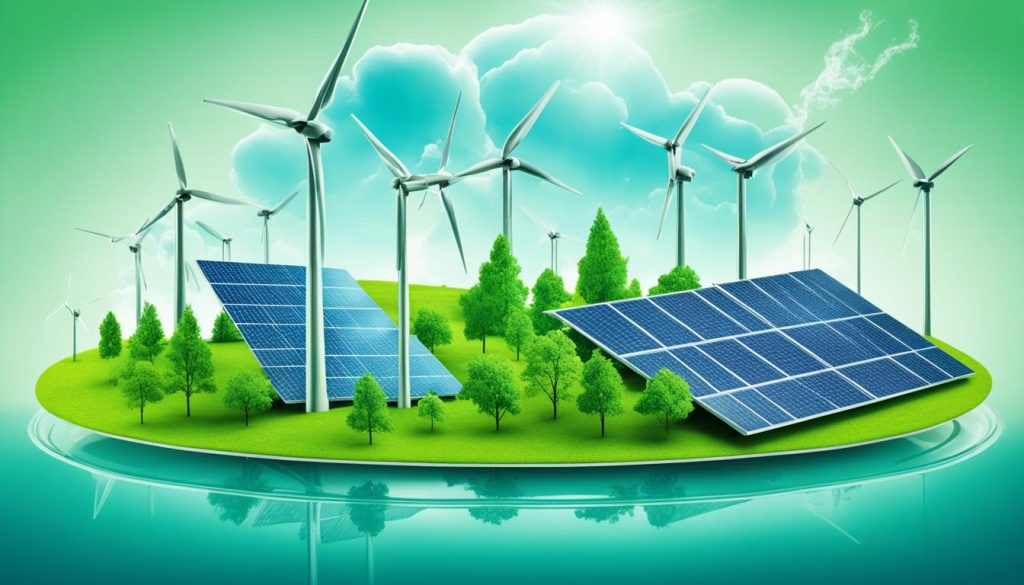
Germany is heading towards a green future. It sees hydrogen energy as key in its strategy. Green hydrogen investment is high on the agenda.
Hydrogen has many uses, from industry to our daily lives. It can power transport, heat homes, and generate electricity. Germany aims to build a strong hydrogen economy through renewable energy innovation.
The focus on green hydrogen investment brings chances for new technology. It’s all about turning wind and solar power into a clean, circular way to make energy. This move cuts down on harmful emissions and promotes long-term green living.
Germany is working hard on hydrogen energy development. It’s investing smartly and doing a lot of research. The goal is to be a leader in the next step of renewable energy innovation, making a better world for everyone.
Energy Efficiency and Consumption Reduction
In Germany, the Energy Efficiency Act shows a strong commitment to use less energy. It lays out goals to cut energy use by 2030 through smart plans. These include better ways to use energy and promoting smart consumer habits.
Goals of the Energy Efficiency Act
The Energy Efficiency Act aims to greatly reduce the need for energy. It pushes for better ways to use energy in all sectors. This includes making sure that companies, homes, and public places use energy in the best ways.
Strategies for Reducing Consumption
Germany has many ways to lower how much energy is used. It supports using things that don’t waste energy, like efficient appliances, and green business practices. They also spread the word on saving energy and have rules for things that use a lot of it. By using new technologies and supporting innovation, Germany is working to cut energy use and keep growing.
Energy Storage and Grid Innovation
Energy storage is key for blending renewable sources into Germany’s power mix. They help during times when the sun isn’t shining or the wind isn’t blowing. This stores extra energy when it’s made a lot, for later when it’s not.
Improving the grid is crucial too. It means using smart technology to make the energy network stronger and more flexible. This upgrade is especially important as more green energy comes online, making the whole system work better for everyone.
Linking up renewable energy with the grid is a big step forward. By improving how it all works together, Germany is able to use more green power. This shift is vital for cutting down on harmful emissions and protecting the environment.
Overall, using smart storage, upgrading the grid, and getting greener power on the grid makes Germany a leader in green energy. It shows how teaming up can create an energy future that’s both strong and good for the planet.
Germany’s Renewable Energy Sector in a European Context
Germany is a leading figure in Europe’s renewable energy shift. It is setting high standards for other EU countries. The Energiewende plan has made Germany’s switch to green energy quicker than many others. This change is not just at home but through teamwork with other EU nations too.
Comparisons with Other EU Countries
In renewable energy, Germany’s progress is very impressive. By 2023, over half of its electricity came from renewable sources. This is well above the EU average. The focus on wind and solar power is influencing other European nations. Denmark and Spain have made big leaps, but Germany’s mix of renewable sources keeps it ahead.
Collaborative Projects and EU Support
Germany is active in many energy projects across Europe. These include wind farms at sea and new grid technologies. The EU helps fund these efforts, showing a joint commitment to clean energy. Mechanisms like the European Green Deal provide strong support. They help Germany and its partners push the use of green technology forward.
Germany’s efforts lead to a more united Europe on green issues. The teamwork and EU support are not only good for Germany. They also make Europe more prepared for environmental challenges. This work is key to reaching sustainable goals all over the continent.

